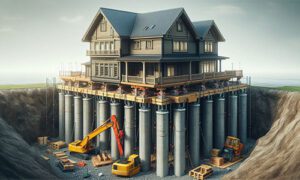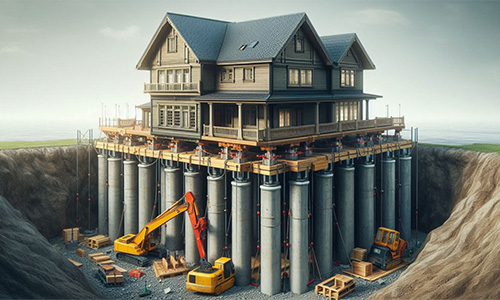
As urban development evolves and land scarcity becomes a growing concern, engineers and builders are turning to innovative techniques to preserve existing structures. One such remarkable innovation is building lifting and shifting engineering. If you’ve ever wondered how a multi-story building can be raised or moved to a new position without demolition, this beginner-friendly guide will explain how it’s done and why it’s becoming increasingly popular.
Table of Contents
What Is Building Lifting and Shifting?
Why Is Building Lifting and Shifting Done?
How Does Building Lifting Work?
How Does Building Shifting Work?
Technologies & Tools Used
Is Building Lifting or Shifting Safe?
Cost of Building Lifting and Shifting
Advantages of Building Lifting & Shifting
Conclusion
FAQ
What Is Building Lifting and Shifting?
Building Lifting service entails elevating a structure vertically from its foundation. This method is employed when the foundation has to be strengthened or changed, or when a building needs to be lifted to defend itself from flooding or other environmental risks. It is also utilized to construct new levels beneath an existing structure. Building Shifting is the process of transporting an entire structure horizontally to a new place. This could include shifting the building on the same site to make additional room or altogether moving it to a new location. Shifting is very useful when historical or irreplaceable buildings need to be preserved rather than demolished.
These methods are a part of structural engineering and demand a combination of precision planning, advanced technology, and experienced manpower and the expertise of a building construction company.
Why Is Building Lifting and Shifting Done?
There are various practical and economic reasons to select this engineering solution:
- Flood protection
In flood-prone areas, raising the building above ground level reduces water damage and increases safety.
- Foundation Strengthening or Reconstruction.
If a building’s foundation is weakened or broken, it can be raised, repaired or rebuilt, and securely reinstalled.
- Basement or Cellar Construction.
Building lifting is frequently utilized to add floors or basements beneath existing structures, providing useful space without changing the footprint.
- Road Level Changes
If road levels around a building rise owing to urban planning, the structure may be raised to match the new height while maintaining accessibility.
- Legal or boundary adjustments.
Sometimes a construction is partially or completely outside the authorized plot limitations. Shifting helps to remedy this without demolishing.
- Protecting Heritage Structures
Historic structures can be relocated to safer or more appropriate settings while retaining their integrity.
How Does Building Lifting Work?
Building or house lifting service entails some technical procedures, undertaken under the guidance of structural engineers and technicians.
Step-by-Step Summary:
- Structural Analysis: Engineers examine the building design, distribution of loads, and materials.
- Soil tests are also conducted to comprehend the state of the foundation.
- Jack Placement: A number of synchronized hydraulic jacks are located at strategic load-bearing locations on the structure.
- Steel beams can be inserted to give additional support.
- Gradual Lifting: The jacks are handled with care to raise the structure inch by inch, distributing the weight evenly to prevent cracks or damage.
- New Foundation Work: After being lifted, the new foundation is set, or the old one is altered or reinforced.
- Lowering & Alignment: The building is lowered slowly onto the new foundation with accurate alignment and rechecked for stability.
How Does Building Shifting Work?
Shifting a building is a bit more intricate than just lifting it, as it requires moving it horizontally.
- First, we start by lifting the structure slightly with hydraulic jacks, just like we would when lifting it.
- Next, we set up a track and roller system. We place heavy-duty rollers or rails underneath the building to ensure it can move smoothly.
- Then comes the gradual horizontal shifting. The structure is carefully moved along the prepared path using push-pull hydraulic systems or winches.
- Finally, once the building has been relocated, we set it down on a new foundation and make sure it’s perfectly aligned.
Technologies & Tools Used
- Hydraulic Jacks & Pumps
- Steel I-beams and Channels
- Rollers, Rails, or Skid Systems
- Laser Alignment Equipment
- Load Monitoring Systems
- Concrete & Foundation Repair Tools
Is Building Lifting or Shifting Safe??
Yes—when done by professionals. Building lifting and shifting is a precise engineering task that requires thorough planning, high-quality materials, and strict adherence to safety protocols.
Cost of Building Lifting and Shifting
Costs vary depending on:
- Size and height of the building
- Type and strength of the foundation
- Distance (if relocation is required)
- Location, soil condition, and accessibility
Advantages of Building Lifting & Shifting
- It saves on both time and costs.
- No demolition or rebuilding has to be done.
- It preserves the architecture.
- Allows for legal alterations or expanding spaces.
- This is quite an environment-saving option compared to building a new one.
Conclusion
Building lifting and shifting engineering is a smart, sustainable alternative to demolition and reconstruction. Whether it’s flood protection, structural reinforcement, or space optimization, this solution offers long-term value and flexibility for both residential and commercial properties.
If you’re facing challenges like foundation damage, road-level mismatches, or land encroachment, consulting professional building lifting companies could help—lifting or shifting your structure might be the innovative solution you didn’t know existed.
Looking for Building Lifting or Shifting Services?
Frequently Asked Questions
It is possible to lift buildings safely without damage with modern hydraulic systems, steel support beams, and expert supervision, but the distribution of loads and planning is critical.
Time varies from a building’s size, structure, soil condition, and complexity. Around 2-4 weeks for a simple residential house lifting project. Shifting can prolong this for even up to 1-3 months.
Flood protection, strengthening the underpinning, adding space for use, such as a basement, thus prolonging the lifespan and value of the building.

